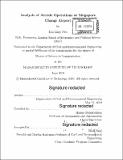Analysis of airside operations at Singapore Changi Airport
Author(s)
Neo, Kai Ling.
Download1129597386-MIT.pdf (13.13Mb)
Other Contributors
Massachusetts Institute of Technology. Department of Civil and Environmental Engineering.
Advisor
Hamsa Balakrishnan.
Terms of use
Metadata
Show full item recordAbstract
Air travel demand has been on an upward trend in recent years, and airports have thus become increasingly congested. To alleviate airport congestion, building new infrastructure such as runways to improve capacity is an obvious solution but it is highly expensive and has a long lead time. In the short term, airport managers and operators have to learn to utilize current capacity more efficiently instead. This begins with the understanding of the current operations and then identifying areas for improvement to better utilize the available capacity. In this thesis, we present a data-driven approach to analyze airport surface operations. The methodology is presented using data from Singapore's Changi Airport, one of the busiest airports in the world and a major transportation hub for Southeast Asia. The current operations at the airport is characterized using multiple data sources to identify inefficiencies such as surface congestion and unsatisfactory runway occupancy times. Using the airport characterization, we develop queuing models for the departure process to estimate congestion-related delays and taxi-out times. The taxi-out time estimates from the queuing models have the potential to improve predictability as well as aid in the decision making process to reduce congestion on the airport surface. In order to reduce congestion, many major airports around the world, including Changi Airport, are improving their capacity by adding additional runways. To better understand the impact of additional runways, we present a detailed capacity analysis with Changi Airport as a case study. Using empirical and theoretical capacity estimates, along with historical data on the impact of airport expansion from similar airports such as Charlotte Douglas International Airport, we estimate the short-term and long-term improvements in throughput at Changi Airport. The analysis and models built in this thesis thus aim to aid Changi Airport's efforts in alleviating congestion in both the short term and the long term, by providing insights on areas for improvement for current operations and potential impacts of future operational decisions.
Description
Thesis: S.M. in Transportation, Massachusetts Institute of Technology, Department of Civil and Environmental Engineering, 2019 Cataloged from PDF version of thesis. Includes bibliographical references (pages 103-105).
Date issued
2019Department
Massachusetts Institute of Technology. Department of Civil and Environmental EngineeringPublisher
Massachusetts Institute of Technology
Keywords
Civil and Environmental Engineering.